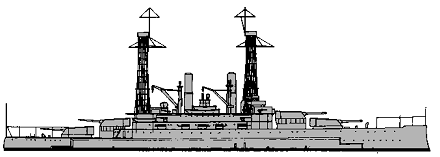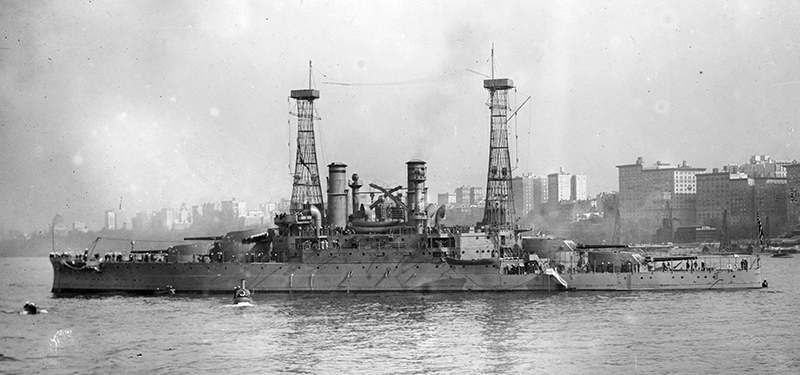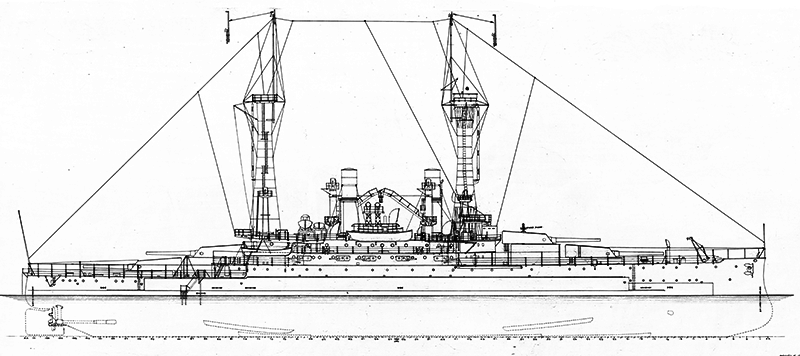

South Carolina 1910
| No | Name | Yard No | Builder | Laid down | Launched | Comm | Fate |
| BB26 | South Carolina | 346 | Cramp, Philadelphia | 18.12.1906 | 11.7.1908 | 1.3.1910 | stricken 11.1923 |
| BB27 | Michigan | 43 | New York SB, Camden | 26.5.1906 | 17.12.1908 | 4.1.1910 | stricken 11.1923 |
|
Displacement normal, t |
16000 |
|
Displacement full, t |
17617 |
|
Length, m |
137.2 wl 138.0 oa |
|
Breadth, m |
24.5 |
|
Draught, m |
7.50 |
|
No of shafts |
2 |
|
Machinery |
2 VTE, 12 Babcock & Wilcox boilers |
|
Power, h. p. |
16500 |
|
Max speed, kts |
18.5 |
|
Fuel, t |
coal 2200 |
| Endurance, nm(kts) | 6950(10) |
|
Armour, mm |
belt: 305 - 203, upper belt: 254 - 203, deck: 64 - 38, barbettes: 254 - 203, turrets: 305 - 64, CT: 305 - 51 |
|
Armament |
4 x 2 - 305/45 Mk V, 22 x 1 - 76/50 Mk VI, 2 - 533 TT (beam) |
|
Complement |
869 |
Project history: The first US single-caliber battleships, they actually preceded HMS Dreadnought in design, but not in construction. They were the last American battleships restricted to 16000t by Congressional mandate, and they conformed to the speed standard of earlier American battleships, 18kts. As a result, they could not operate tactically with the later dreadnoughts, and were often listed with the pre-dreadnoughts.
Their concept resulted from gunnery advances, largely due to Captain William S. Sims. The Bureau of Construction and Repair (C & R) was asked to design a new type of battleship in 1904, and Sims and his colleagues found the bureau much too slow to act; that was probably the origin of the reform movement which, four years later, made the General Board responsible for ship characteristics. Very little of the design background of the class has survived, possibly in part because C&R itself found the episode so embarrassing.
It appears that the bureau's initial approach was a relatively conventional design with twin 305mm turrets on the centreline fore and aft, and four single turrets replacing the twin 203mm mounts of earlier pre-dreadnoughts. These designs apparently encountered severe structural problems, presumably particularly because Congress limited new battleships to a maximum of 16000t. Chief Constructor Washington L. Capps then chose the radical superfiring arrangement for which the ships were subsequently known. In March 1907 it was tested aboard the monitor Florida one of the two 305mm guns in the ship's turret was removed and mounted to superfire above and behind, and a dummy wooden gun mounted in its place; animals and then men were placed in the turret to test the blast effects of superfiring. By this time South Carolina could not really have been altered; presumably the issue was whether the ship could fire four guns ahead or astern.
This class also introduced the cage masts characteristics of US dreadnoughts. The original design incorporated a pair of pole masts with a fire control bridge slung between them, but the ships were completed with cages fore and aft on the centreline, and the poles were cut down to serve as kingposts for boat cranes.
Ship protection: Main belt had 2.44m height (1.3m over and 1.14m under waterline). Amidships the belt was 254mm thick at 1.6m upper part tapering to 203mm at lower edge. Main belt thickness increased up to 305 / 254mm abreast magazines and 280 / 229mm abreast machinery. Next fore (from citadel up to 17 span) part of belt was 254mm at upper edge tapering to 203mm at lower edge. Ship ends by waterline were protected by 38mm armour. Belt was connected with end barbettes by 254 / 203mm bulkheads. There was upper belt, 254mm thick at lower and 203mm at upper edges with equal 254 / 203mm bulkheads. 76mm guns casemate was unarmoured. Flat armoured deck was connected with upper edge of main belt and was 38mm over machinery, 51mm over aft and 57mm over fore magazines. This deck had 38mm thickness fwd from citadel and 70mm aft. It was 76mm and had 76mm slopes over steering gear. Main gun turrets had 305mm faces, 203mm sides and rears and 64mm crowns. Barbettes were 254mm at upper and 203mm at lower edges. CT had 305mm sides and 51mm roof. Funnel uptakes were protected by 38mm armour.
Modernizations: about 1917 - 1918, both: - 10 x 1 - 76/50
1918, both: + 2 x 1 - 76/52 Mk X
Naval service: No significant events.

South Carolina 1912

Michigan

Michigan
© Navypedia, 2020